Abstract
Escherichia coli K1 strains, isolated from human newborns with meningitis, were fed to pathogen-free Sprague-Dawley infant rats by an oral gastric tube. Feeding of 10(3) to 10(11) organisms colonized the intestine of approximately 70% of the animals. At 5 days postfeeding of 3- to 5-day-old rats, bacteremia was detected in 60%, and meningitis occurred in 15% of bacteremic animals. Colonization and bacteremia were age-related. Rats 15 days old had only 19 colonization and 10% bacteremia, and those 30 days old were almost completely resistant to colonization and bacteremia. The intranasal route was less effective in inducing colonization and bacteremia. Intralitter transmission from E. coli K1-fed rats occurred, with 52% of water-fed controls becoming colonized and 15% become bacteremic. Colonization of mothers from their fed infants occurred, but none of five tested developed bacteremia. Other E. coli capsular polysaccharide types were studied. A K92 strain isolated from a newborn with meningitis induced a 77% colonization rate, and 8% of these developed bacteremia without detectable meningitis. An E. coli K100 strain showed a 32% colonization rate, and 2% developed bacteremia. The age relation, relatively high virulence of K1 compared with other capsular types, spontaneous appearance of colonization, bacteremia, and meningitis, and intralitter transmission of colonization and disease in newborn rats closely parellel E. coli epidemiology in human neonates.
Full text
PDF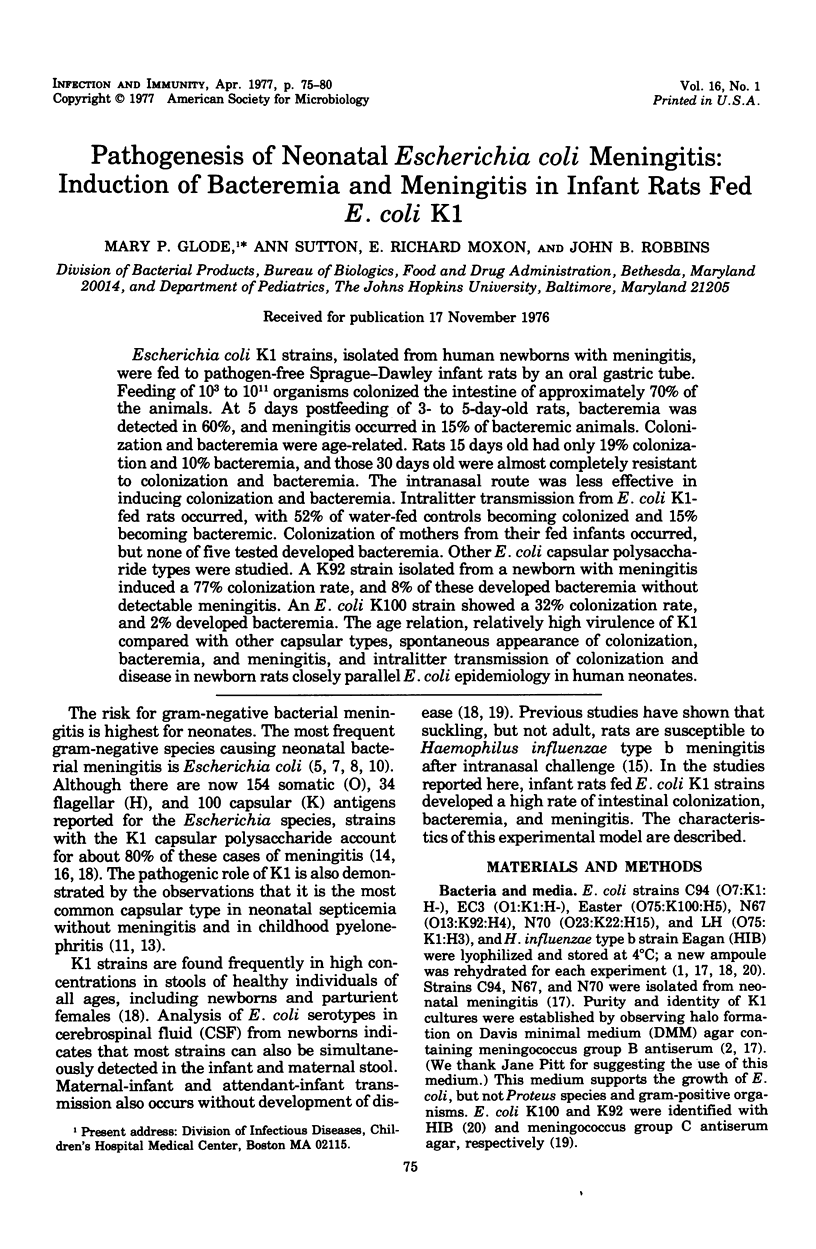
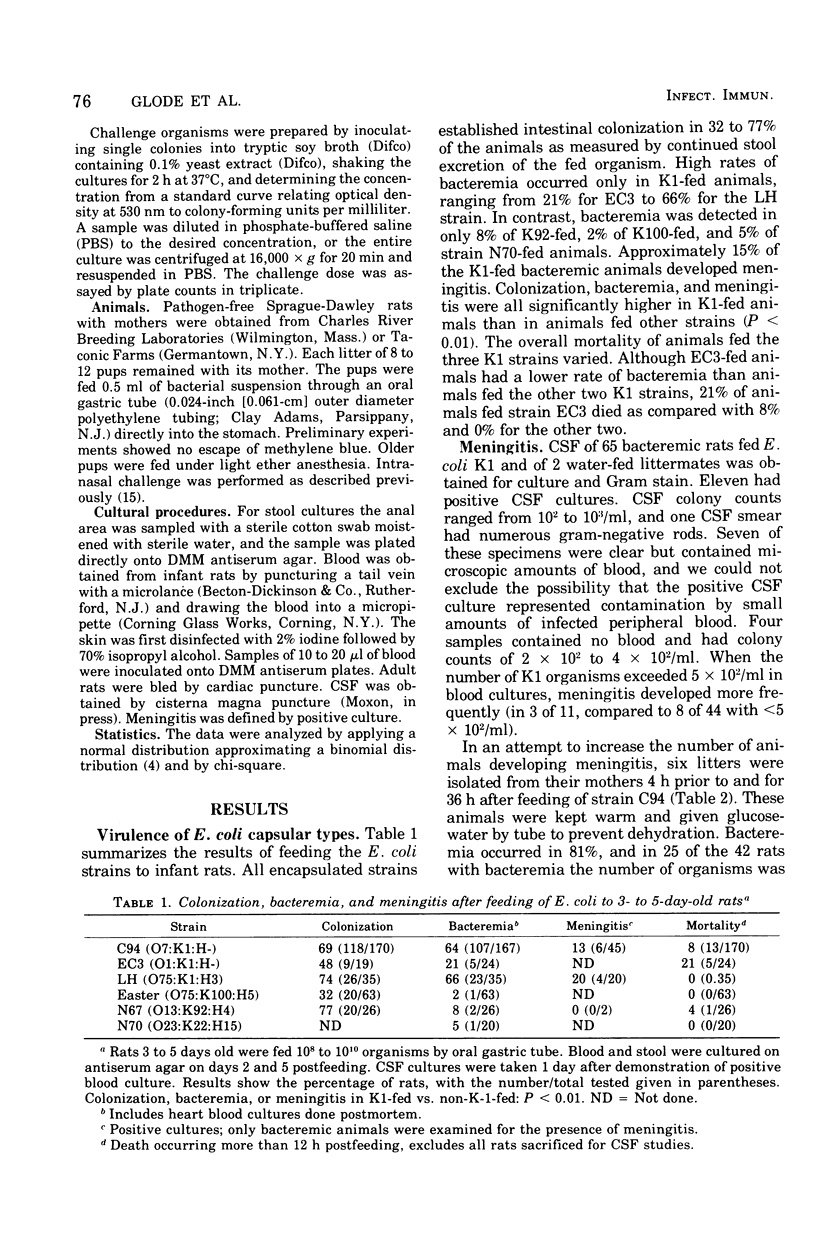
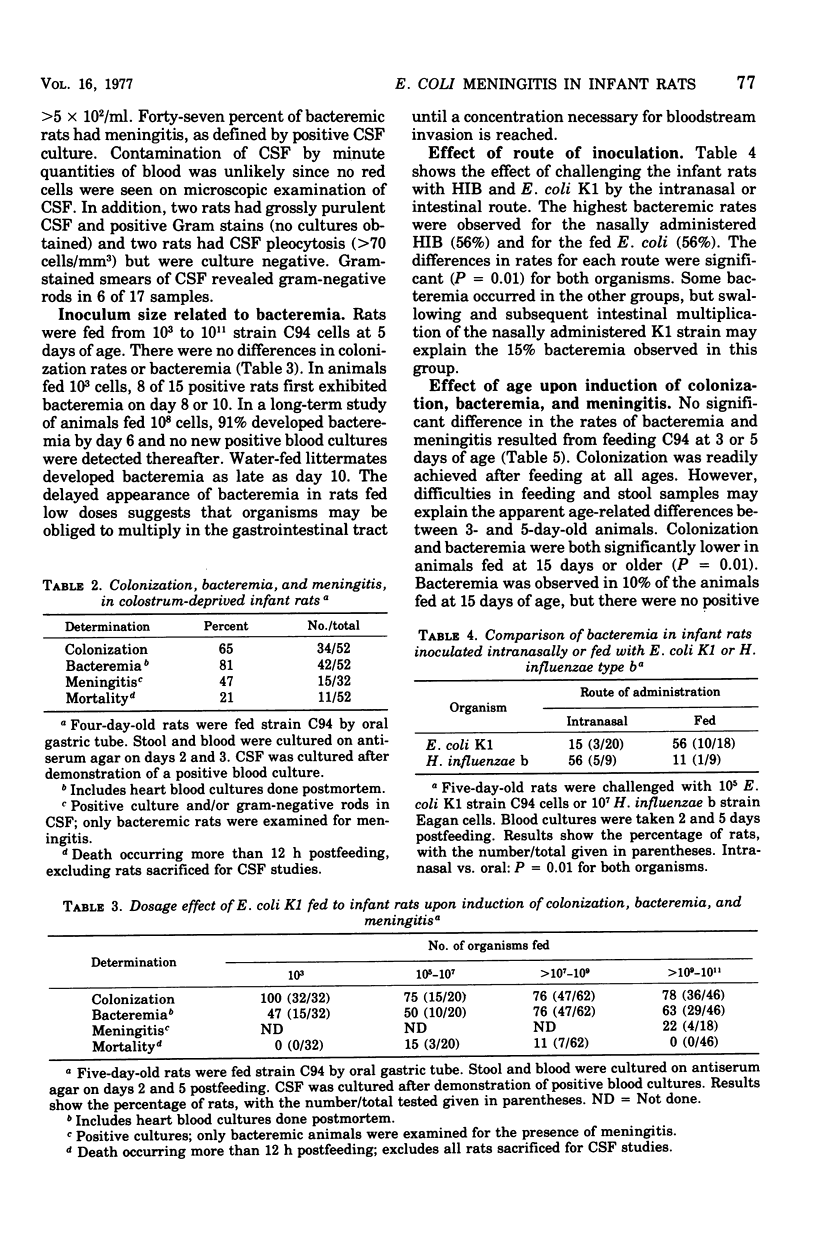
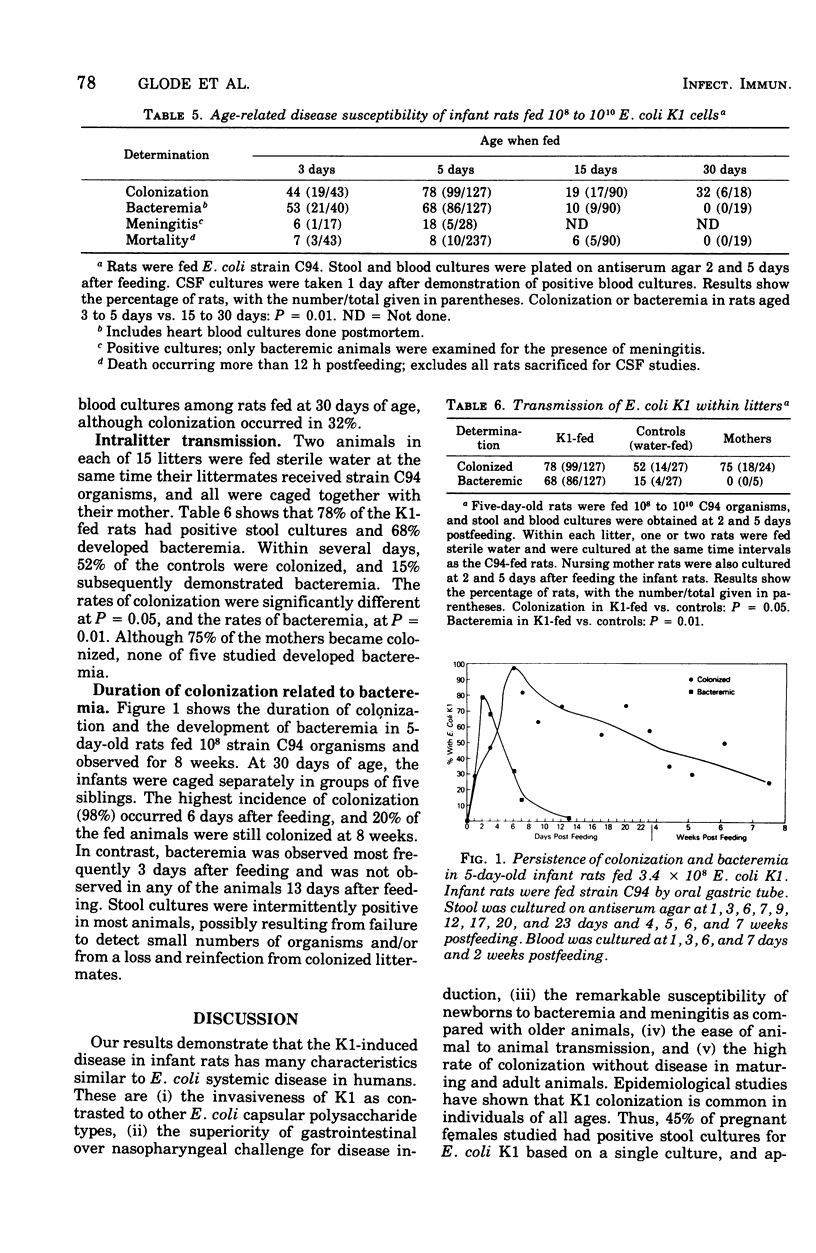
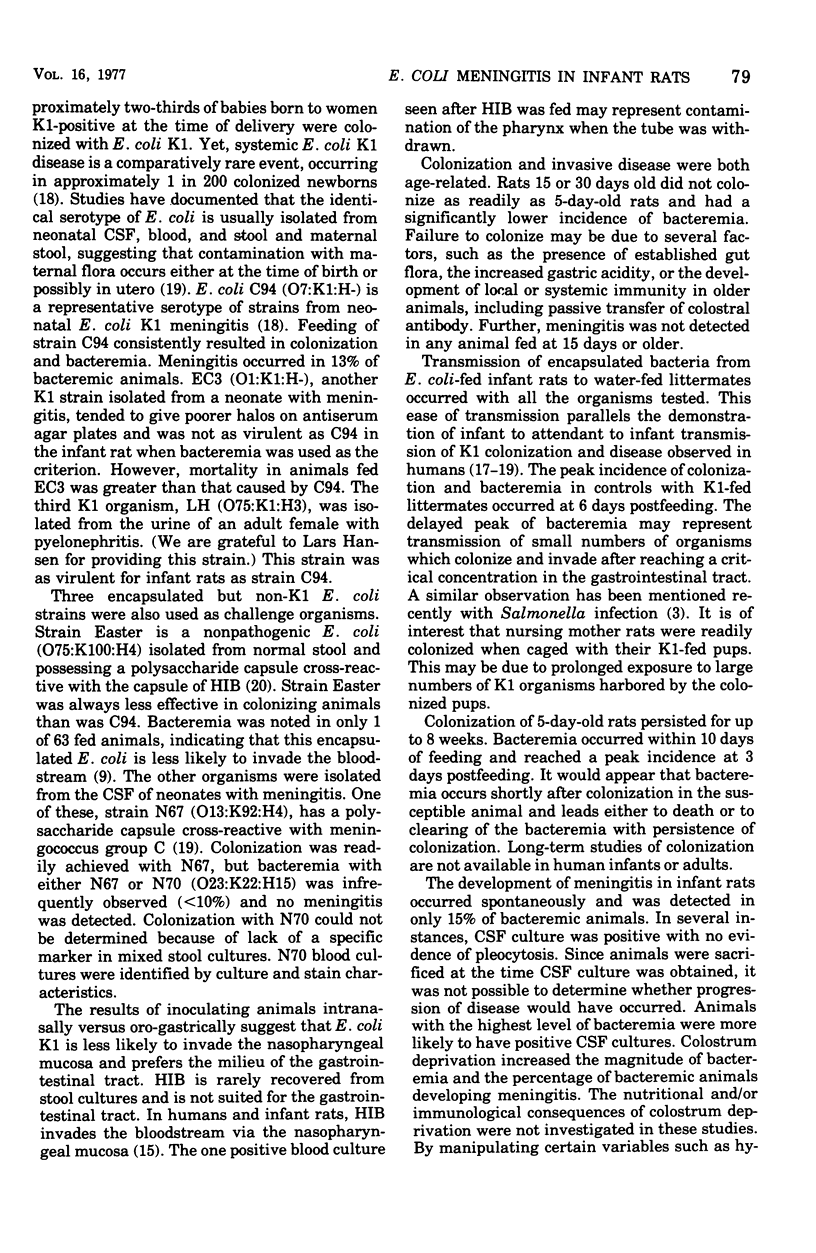
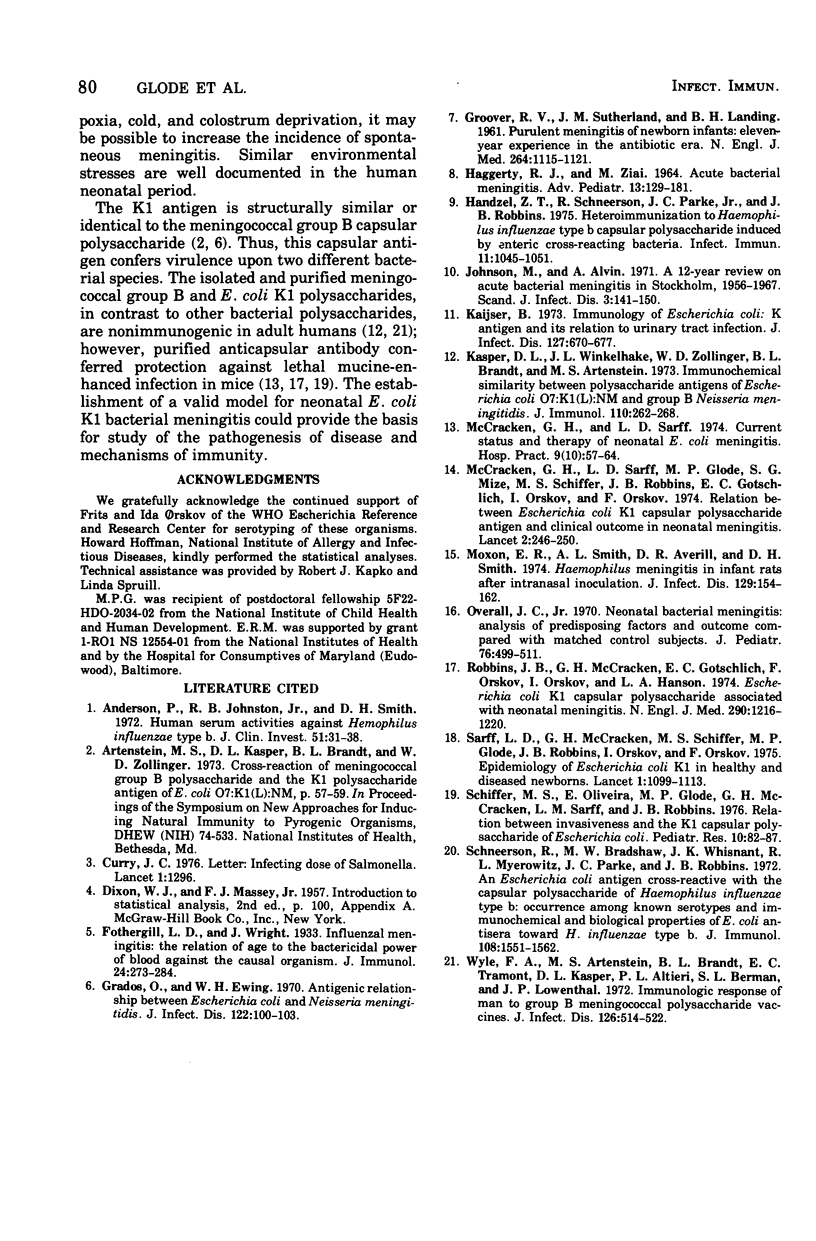
Selected References
These references are in PubMed. This may not be the complete list of references from this article.
- Anderson P., Johnston R. B., Jr, Smith D. H. Human serum activities against Hemophilus influenzae, type b. J Clin Invest. 1972 Jan;51(1):31–38. doi: 10.1172/JCI106793. [DOI] [PMC free article] [PubMed] [Google Scholar]
- Curry J. C. Infecting dose of salmonella. Lancet. 1976 Jun 12;1(7972):1296–1296. doi: 10.1016/s0140-6736(76)91765-7. [DOI] [PubMed] [Google Scholar]
- GROOVER R. V., SUTHERLAND J. M., LANDING B. H. Purulent meningitis of newborn infants. Eleven-year experience in the antibiotic era. N Engl J Med. 1961 Jun 1;264:1115–1121. doi: 10.1056/NEJM196106012642201. [DOI] [PubMed] [Google Scholar]
- Grados O., Ewing W. H. Antigenic relationship between Escherichia coli and Neisseria meningitidis. J Infect Dis. 1970 Jul-Aug;122(1):100–103. doi: 10.1093/infdis/122.1-2.100. [DOI] [PubMed] [Google Scholar]
- HAGGERTY R. J., ZIAI M. ACUTE BACTERIAL MENINGITIS. Adv Pediatr. 1964;13:129–181. [PubMed] [Google Scholar]
- Handzel Z. T., Argaman M., Parke J. C., Jr, Schneerson R., Robbins J. B. Heteroimmunization to the capsular polysaccharide of Haemophilus influenzae type b induced by enteric cross-reacting bacteria. Infect Immun. 1975 May;11(5):1045–1052. doi: 10.1128/iai.11.5.1045-1052.1975. [DOI] [PMC free article] [PubMed] [Google Scholar]
- Jonsson M., Alvin A. A 12-year review of acute bacterial meningitis in Stockholm. Scand J Infect Dis. 1971;3(2):141–150. doi: 10.3109/inf.1971.3.issue-2.08. [DOI] [PubMed] [Google Scholar]
- Kaijser B. Immunology of Escherichia coli: K antigen and its relation to urinary-tract infection. J Infect Dis. 1973 Jun;127(6):670–677. doi: 10.1093/infdis/127.6.670. [DOI] [PubMed] [Google Scholar]
- Kasper D. L., Winkelhake J. L., Zollinger W. D., Brandt B. L., Artenstein M. S. Immunochemical similarity between polysaccharide antigens of Escherichia coli 07: K1(L):NM and group B Neisseria meningitidis. J Immunol. 1973 Jan;110(1):262–268. [PubMed] [Google Scholar]
- McCracken G. H., Jr, Sarff L. D., Glode M. P., Mize S. G., Schiffer M. S., Robbins J. B., Gotschlich E. C., Orskov I., Orskov F. Relation between Escherichia coli K1 capsular polysaccharide antigen and clinical outcome in neonatal meningitis. Lancet. 1974 Aug 3;2(7875):246–250. doi: 10.1016/s0140-6736(74)91413-5. [DOI] [PubMed] [Google Scholar]
- Moxon E. R., Smith A. L., Averill D. R., Smith D. H. Haemophilus influenzae meningitis in infant rats after intranasal inoculation. J Infect Dis. 1974 Feb;129(2):154–162. doi: 10.1093/infdis/129.2.154. [DOI] [PubMed] [Google Scholar]
- Overall J. C., Jr Neonatal bacterial meningitis. Analysis of predisposing factors and outcome compared with matched control subjects. J Pediatr. 1970 Apr;76(4):499–511. doi: 10.1016/s0022-3476(70)80399-7. [DOI] [PubMed] [Google Scholar]
- Robbins J. B., McCracken G. H., Jr, Gotschlich E. C., Orskov F., Orskov I., Hanson L. A. Escherichia coli K1 capsular polysaccharide associated with neonatal meningitis. N Engl J Med. 1974 May 30;290(22):1216–1220. doi: 10.1056/NEJM197405302902202. [DOI] [PubMed] [Google Scholar]
- Sarff L. D., McCracken G. H., Schiffer M. S., Glode M. P., Robbins J. B., Orskov I., Orskov F. Epidemiology of Escherichia coli K1 in healthy and diseased newborns. Lancet. 1975 May 17;1(7916):1099–1104. doi: 10.1016/s0140-6736(75)92496-4. [DOI] [PubMed] [Google Scholar]
- Schiffer M. S., Oliveira E., Glode M. P., McCracken G. H., Jr, Sarff L. M., Robbins J. B. A review: relation between invasiveness and the K1 capsular polysaccharide of Escherichia coli. Pediatr Res. 1976 Feb;10(2):82–87. doi: 10.1203/00006450-197602000-00002. [DOI] [PubMed] [Google Scholar]
- Schneerson R., Bradshaw M., Whisnant J. K., Myerowitz R. L., Parke J. C., Jr, Robbins J. B. An Escherichia coli antigen cross-reactive with the capsular polysaccharide of Haemophilus influenzae type b: occurrence among known serotypes, and immunochemical and biologic properties of E. coli antisera toward H. influenzae type b. J Immunol. 1972 Jun;108(6):1551–1562. [PubMed] [Google Scholar]
- Wyle F. A., Artenstein M. S., Brandt B. L., Tramont E. C., Kasper D. L., Altieri P. L., Berman S. L., Lowenthal J. P. Immunologic response of man to group B meningococcal polysaccharide vaccines. J Infect Dis. 1972 Nov;126(5):514–521. doi: 10.1093/infdis/126.5.514. [DOI] [PubMed] [Google Scholar]


